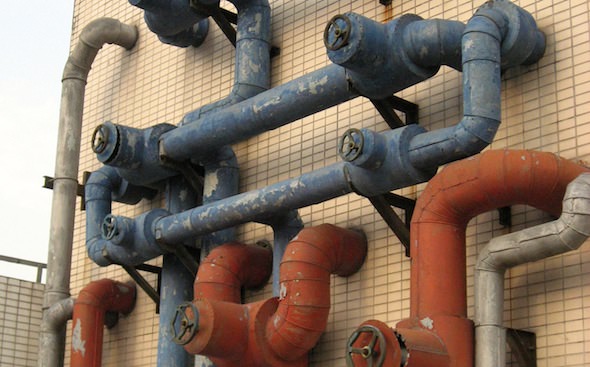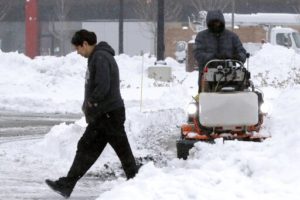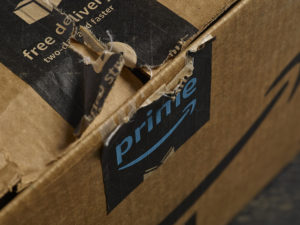No Pipe Dream
Spectra Energy, one of the largest natural gas infrastructure companies in North America, had proposed changes in a pipeline it owns, the Algonquin, which runs from Texas into my hometown, Boston. Suddenly, I’m in the crosshairs of the fracking industry, too.
By Ellen Cantarow, TomDispatch
This piece first appeared at TomDispatch. Read Nick Turse’s introduction here.
For the past several years, I’ve been writing about what happens when big oil and gas corporations drill where people live. “Fracking” — high-volume hydraulic fracturing, which extracts oil and methane from deep shale — has become my beat. My interviewees live in Pennsylvania’s shale-gas fields; among Wisconsin’s hills, where corporations have been mining silica, an essential fracking ingredient; and in New York, where one of the most powerful grassroots movements in the state’s long history of dissent has become ground zero for anti-fracking activism across the country. Some of the people I’ve met have become friends. We email, talk by phone, and visit. But until recently I’d always felt at a remove from the dangers they face: contaminated water wells, poisoned air, sick and dying animals, industry-related illnesses. Under Massachusetts, where I live, lie no methane- or oil-rich shale deposits, so there’s no drilling.
But this past September, I learned that Spectra Energy, one of the largest natural gas infrastructure companies in North America, had proposed changes in a pipeline it owns, the Algonquin, which runs from Texas into my hometown, Boston. The expanded Algonquin would carry unconventional gas — gas extracted from deep rock formations like shale — into Massachusetts from the great Marcellus formation that sprawls along the Appalachian basin from West Virginia to New York. Suddenly, I’m in the crosshairs of the fracking industry, too.
We all are.
Gas fracked from shale formations goes by several names (“unconventional gas,” “natural gas,” “shale gas”), but whatever it’s called, it’s mainly methane. Though we may not know it, fracked gas increasingly fuels our stoves and furnaces. It also helps to fuel the floods, hurricanes, droughts, wildfires, and ever-hotter summers that are engulfing the planet. The industry’s global-warming footprint is actually greater than that of coal. (A Cornell University study that established this in 2011 has been reconfirmed since.) Methane is a far more powerful greenhouse gas than carbon dioxide (CO2) and an ecological nightmare due to its potential for dangerous leaks.
According to former Mobil Oil executive Lou Allstadt, the greatest danger of fracking is the methane it adds to the atmosphere through leaks from wells, pipelines, and other associated infrastructure. The National Oceanic and Atmospheric Administration has found leakage rates of 2.3% to 17% of annual production at gas and oil fields in California, Colorado, and Utah. Moreover, no technology can guarantee long-term safety decades into the future when it comes to well casings (there are hundreds of thousands of frack wells in the U.S. to date) or in the millions of miles of pipelines that crisscross this country.
The energy industry boasts that fracking is a “bridge” to renewable energies, but a 2012 Massachusetts Institute of Technology study found that shale gas development could end up crowding out alternative energies. That’s because as fracking spreads, it drives natural gas prices down, spurring greater consumer use, and so more fracking. In a country deficient in regulations and high in corporate pressures on government, this cascade effect creates enormous disincentives for investment in large alternative energy programs.
The sorry state of U.S. renewable energy development proves the case. As the fracking industry has surged, the country continues to lag far behind Germany and Denmark, the world’s renewable-energy leaders. A quarter-century after the world’s leading climate change scientist, James Hansen, first warned Congress about global warming, Americans have only bad options: coal, shale gas, oil, or nuclear power.
Living in Gasland
There’s been a great deal of reporting about “the drilling part” of fracking — the moment when drills penetrate shale and millions of gallons of chemical-and-sand-laced water are pumped down at high pressure to fracture the rock. Not so much has been written about all that follows. It’s the “everything else” that has turned a drilling technology into a land-and-water-devouring industry so vast that it’s arguably one of the most pervasive extractive adventures in history.
According to Cornell University’s Anthony Ingraffea, the co-author of a study that established the global warming footprint of the industry, fracking “involves much more than drill-the-well-frack-the-well-connect-the-pipeline-and-go-away.” Almost all other industries “occur in a zoned industrial area, inside of buildings, separated from home and farm, separated from schools.” By contrast, the industry spawned by fracking “permits the oil and gas industries to establish [their infrastructures] next to where we live. They are imposing on us the requirement to locate our homes, hospitals, and schools inside their industrial space.”
Wells, flanked by batteries of vats, tanks, and diesel trucks, often stand less than a mile from homes. So do compressor stations that condense gas for its long journey through pipelines, and which are known to emit carcinogens and neurotoxins. Radioactive waste (spewed up in fracking flow-back and drill cuttings) gets dumped on roads and in ordinary waste sites. Liquified natural gas (LNG) terminals that move this energy source for export are a constant danger due to explosions, fires, spills, and leaks. Every part of the fracking colossus, it seems, has its rap sheet of potential environmental and public health harms.
For the past several years, I’ve been writing about what happens when big oil and gas corporations drill where people live. “Fracking” — high-volume hydraulic fracturing, which extracts oil and methane from deep shale — has become my beat. My interviewees live in Pennsylvania’s shale-gas fields; among Wisconsin’s hills, where corporations have been mining silica, an essential fracking ingredient; and in New York, where one of the most powerful grassroots movements in the state’s long history of dissent has become ground zero for anti-fracking activism across the country. Some of the people I’ve met have become friends. We email, talk by phone, and visit. But until recently I’d always felt at a remove from the dangers they face: contaminated water wells, poisoned air, sick and dying animals, industry-related illnesses. Under Massachusetts, where I live, lie no methane- or oil-rich shale deposits, so there’s no drilling.
But this past September, I learned that Spectra Energy, one of the largest natural gas infrastructure companies in North America, had proposed changes in a pipeline it owns, the Algonquin, which runs from Texas into my hometown, Boston. The expanded Algonquin would carry unconventional gas — gas extracted from deep rock formations like shale — into Massachusetts from the great Marcellus formation that sprawls along the Appalachian basin from West Virginia to New York. Suddenly, I’m in the crosshairs of the fracking industry, too.
We all are.
Gas fracked from shale formations goes by several names (“unconventional gas,” “natural gas,” “shale gas”), but whatever it’s called, it’s mainly methane. Though we may not know it, fracked gas increasingly fuels our stoves and furnaces. It also helps to fuel the floods, hurricanes, droughts, wildfires, and ever-hotter summers that are engulfing the planet. The industry’s global-warming footprint is actually greater than that of coal. (A Cornell University study that established this in 2011 has been reconfirmed since.) Methane is a far more powerful greenhouse gas than carbon dioxide (CO2) and an ecological nightmare due to its potential for dangerous leaks.
According to former Mobil Oil executive Lou Allstadt, the greatest danger of fracking is the methane it adds to the atmosphere through leaks from wells, pipelines, and other associated infrastructure. The National Oceanic and Atmospheric Administration has found leakage rates of 2.3% to 17% of annual production at gas and oil fields in California, Colorado, and Utah. Moreover, no technology can guarantee long-term safety decades into the future when it comes to well casings (there are hundreds of thousands of frack wells in the U.S. to date) or in the millions of miles of pipelines that crisscross this country.
The energy industry boasts that fracking is a “bridge” to renewable energies, but a 2012 Massachusetts Institute of Technology study found that shale gas development could end up crowding out alternative energies. That’s because as fracking spreads, it drives natural gas prices down, spurring greater consumer use, and so more fracking. In a country deficient in regulations and high in corporate pressures on government, this cascade effect creates enormous disincentives for investment in large alternative energy programs.
The sorry state of U.S. renewable energy development proves the case. As the fracking industry has surged, the country continues to lag far behind Germany and Denmark, the world’s renewable-energy leaders. A quarter-century after the world’s leading climate change scientist, James Hansen, first warned Congress about global warming, Americans have only bad options: coal, shale gas, oil, or nuclear power.
Living in Gasland
There’s been a great deal of reporting about “the drilling part” of fracking — the moment when drills penetrate shale and millions of gallons of chemical-and-sand-laced water are pumped down at high pressure to fracture the rock. Not so much has been written about all that follows. It’s the “everything else” that has turned a drilling technology into a land-and-water-devouring industry so vast that it’s arguably one of the most pervasive extractive adventures in history.
According to Cornell University’s Anthony Ingraffea, the co-author of a study that established the global warming footprint of the industry, fracking “involves much more than drill-the-well-frack-the-well-connect-the-pipeline-and-go-away.” Almost all other industries “occur in a zoned industrial area, inside of buildings, separated from home and farm, separated from schools.” By contrast, the industry spawned by fracking “permits the oil and gas industries to establish [their infrastructures] next to where we live. They are imposing on us the requirement to locate our homes, hospitals, and schools inside their industrial space.”
Wells, flanked by batteries of vats, tanks, and diesel trucks, often stand less than a mile from homes. So do compressor stations that condense gas for its long journey through pipelines, and which are known to emit carcinogens and neurotoxins. Radioactive waste (spewed up in fracking flow-back and drill cuttings) gets dumped on roads and in ordinary waste sites. Liquified natural gas (LNG) terminals that move this energy source for export are a constant danger due to explosions, fires, spills, and leaks. Every part of the fracking colossus, it seems, has its rap sheet of potential environmental and public health harms.
The Bixbys were offered more money than Briggs — more than $62,000 — for a pipeline right of way and they, too, turned it down. He and his wife are holding fast and so, he says, are 60 neighbors. “They don’t want it to bust up this little valley.” Pointing, he added, “There’s gonna be a path up our woods there as far as you can see, [and] there’s gonna be another one over there. That’s nothing nice to look at.”
Driving around New York and Pennsylvania you’ll spot odd, denuded stretches running down hillsides like ski jumps. On the crests of the hills, the remains of tree lines look like Mohawk haircuts on either side of shaved pipeline slopes. This is only the most obvious sign of pipeline environmental degradation. The Constitution pipeline would also impact 37 Catskills trout streams, endangering aquatic life. According to Kate Hudson, Watershed Program Director at Riverkeeper, one of the state’s most venerable environmental watchdog organizations, the pipeline would “cross hundreds of streams and wetlands by literally digging a hole through them… Any project that jeopardizes multiple water resources in two states is clearly against the public’s interest.”
Holding the Line
Longtime residents aren’t alone in opposing the building of the Constitution pipeline. This tranquil region has been attracting retirees like Bob Stack, a former electrical engineer. In 2004, he and his wife, Anne, bought 97 acres near Leona Briggs’s home. Their dream: to build a straw bale house, a sustainable structure that uses straw for insulation. No sooner had engineers visited the land to start planning than the couple got a letter from Constitution Pipeline LLC. “We were absolutely clueless. We knew nothing about fracking or about pipelines. Fracking was about as remote from us as oil in Iraq or someplace else,” says Anne. “We just looked at each other and said, ‘What an outrage!’” The Stacks, who moved east from Nevada, are now living in limbo.
“Once you have this pulsing fossil fuel energy coming through, it will… industrialize the Susquehanna River valley,” says Anne Marie Garti, who in June 2012 co-founded a local activist group, Stop the Pipeline. (“The unConstitutional Pipeline” reads the organization’s website banner.) “They’re going to start building factories. There’s an interstate, a railroad, there’s cheap labor, and there’s a river to dump the toxins in.”
Garti, a small, quietly assertive former interactive computer software designer, is now a lawyer; her aim: helping people like Briggs and the Bixbys. She grew up in the town of Delhi, near Briggs’s home. In 2008, she found herself among a small group of activists who convinced New York’s then-Governor David Paterson to impose a moratorium on fracking. Under the measure’s shelter a powerful grassroots anti-fracking movement grew, using zoning ordinances to ban drilling in municipalities.
Mark Pezzati, a graphic designer, helped get his town, Andes, in New York’s Delaware County to enact a fracking ban. “Pipeline news wasn’t high on the radar [then],” he says. “Most people were concerned about drilling.” In 2010, Pezzati was shocked to discover that a pipeline called the Millennium had penetrated his state.
It turned out that local land use laws govern only drilling. Under the 1938 Natural Gas Act, pipelines and compressor stations represent interstate commerce. “Suddenly there was this frantic flurry of emails, where people were saying, ‘We’ve got to meet and make people aware.’” (The meeting took place and 200 people flocked to listen to Garti.) “As time went on,” adds Pezzati, “it became apparent that you really can’t frack without a pipeline. There’s no point in drilling if there’s nowhere for the gas to go. So a light bulb went on. If you could stop pipelines you could stop fracking.”
That was when Pezzati and his friends, used to arguing for bans at town board meetings, came up against the Federal Energy Regulatory Commission (FERC), which, among other responsibilities, regulates interstate natural gas transmission. It tilts to corporations, and even Garti found the bureaucratic hurdles it posed daunting. “I have some experience and training in environmental law and it took me a month to figure out the intricacies of FERC’s process,” she told me.
Because FERC refused to disclose the names of landowners in the pipeline’s path, Garti, Pezzati and about a dozen other volunteers had to pore over county tax databases, matching names and addresses to the proposed route. “First we sent letters, then we did door-to-door outreach,” says Garti. Her basic message to landowners along the right of way: “Just say no.”
“People are kind of impressed that you came all the way to their house,” Pezzati points out. “There’s not that many landowners in favor.”
Garti attributes local resentment against the pipeline corporations and their threats to exercise eminent domain to a “fierce” regional “independence” dating back to the anti-rent struggles of tenant farmers against wealthy landlords in the nineteenth century. “People don’t like the idea of somebody coming on their land and taking it from them.”
The activists drafted a letter refusing entry to corporate representatives and circulated it to local landowners. By October 2012, Stop the Pipeline was able to marshal a crowd of 800 for a public hearing called by FERC — “a big crowd for a sparsely populated rural area,” Garti recalls. The vast majority opposed the pipeline’s construction. By January 2013, 1,000 people had sent in statements of opposition.
The organization has created a website with instructions about FERC procedures and handouts for local organizing, as well as a list of organizations opposing the pipeline. These include the Clean Air Council and Trout Unlimited. Among state and federal agencies expressing concerns to FERC have been the Army Corps of Engineers and New York State’s Department of Environmental Conservation, known in earlier fracking battles for its collusion with the gas industry.
“Just like we have a fracking story that’s different in New York State, we have a pipeline story that’s different,” says Garti. “The force of the opposition to pipelines is in New York State. And we have a shot at winning this thing.”
Coming Home
Having covered the environmental degradation of Pennsylvania’s shale gas fields, the wastelands that were Wisconsin’s silica-rich hills, and tiny New York towns where grassroots fracking battles are ongoing, I now have a sense of what it means to be in the crosshairs of the fracking industry. But it was nothing compared to how I felt when I learned Spectra Energy had its sights set on my hometown, Boston.
Fracking isn’t just about drilling and wells and extracting a difficult energy source at a painful cost to the environment. Corporations like Spectra have designs on spreading their pipelines through state after state, through thousands of backyards and farm fields and forests and watersheds. That means thousands of miles of pipe that may leave ravaged landscapes, produce methane leaks, and even, perhaps, lead to catastrophic explosions — and odds are those pipelines are coming to a town near you.
Spectra’s website explains that the Algonquin pipeline “will provide the Northeast with a unique opportunity to secure a… domestically produced source of energy to support its current demand, as well as its future growth.“ Translation: Spectra aims to expand fracking as long as that’s possible. And a glance at any industry source like Oil & Gas Journal shows other corporations hotly pursuing the same goal. (A new New-York-based group, Stop the Algonquin Pipeline Expansion, is the center of opposition to this project.)
It remains to be seen whether the people of Massachusetts will undertake the same type of grassroots efforts, exhibit the same fortitude as Bob and Anne Stack and Leona Briggs, or demonstrate the same organizing acumen as Anne Marie Garti and Mark Pezzati. But Massachusetts citizens had better get organized if they want to stop Spectra Energy and halt its plans to run the Algonquin all the way from Texas northward to Boston and beyond. Fracking is on its way to my doorstep — and yours. Who’s going to hold the line in your town?
Tom Dispatch regular Ellen Cantarow reported on Israel and the West Bank from 1979 to 2009 for the Village Voice, Mother Jones, Inquiry, and Grand Street, among other publications. For the past four years she has been writing about the toll the oil and gas industries are taking on the environment.
Copyright 2014 Ellen Cantarow
Your support matters…Independent journalism is under threat and overshadowed by heavily funded mainstream media.
You can help level the playing field. Become a member.
Your tax-deductible contribution keeps us digging beneath the headlines to give you thought-provoking, investigative reporting and analysis that unearths what's really happening- without compromise.
Give today to support our courageous, independent journalists.





You need to be a supporter to comment.
There are currently no responses to this article.
Be the first to respond.